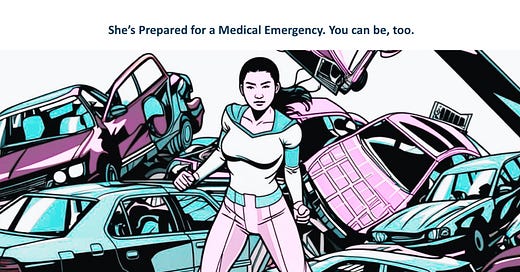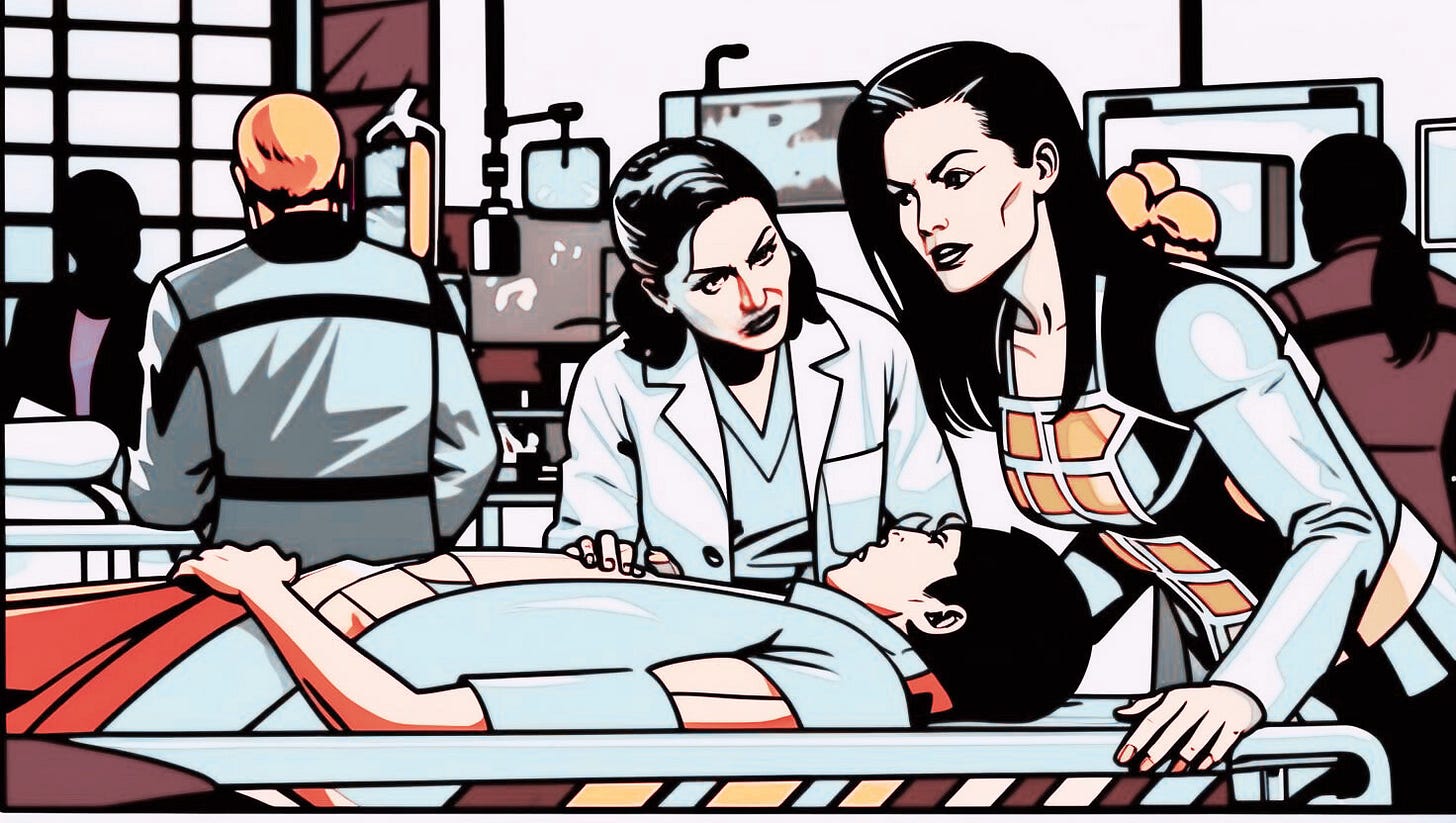Chapter 4: How To Prepare For A Medical Emergency Now
Just a few steps can help you maintain some control
When I was little, the only thing my mother told me about preparing for an emergency was to make certain I always wore clean underwear with no holes. She worried, "What if you're in an accident?" But, when I broke my arm, she never asked what I was wearing; she called a taxi and focused on getting to the local emergency department (ED) quickly.
No one ever plans to have a medical emergency. It never happens at a convenient time or place. Illness, accidents, and dramatic medical events are mostly out of our control but they happen a lot. Every year in the U.S. there are approximately 140 million visits to the ED. That’s an average of 43 visits per 100 people. Odds are you will end up in the ED for yourself or a loved one in the near future.
I've spent a lot of time in emergency rooms as a mom and as a daughter. I've made many mistakes as both. I’ve been there for dumb reasons –– like the time my son caught a baseball with his eye –– and for scary ones –– when we feared my dad had had a stroke. So, what can we do besides wear our good underwear? It turns out, the answer is plenty.
Start With A Change Of Attitude About Emergencies
Don't worry about being a burden, not wanting to make a fuss, being embarrassed, thinking you can ride it out, or anything else that doesn't place your life and health first. That way danger lies. Traditionally, men were more likely to avoid hospitals than women but the gap is narrowing. Women are more likely to request an ambulance when a man is having a heart attack than they will for themselves. That has to change.
If it is truly an emergency, call 911. How will you know? Emergencies are generally defined as life-threatening circumstances affecting your heart, lungs, respiratory system (ability to breathe), significant blood loss, loss of consciousness, or any sudden dramatic change in your body or mind. If you’re the one calling, stay calm, describe what you observe, and clearly state the address.
Emergency physicians say, when in doubt, call 911. Insurance companies often disagree because emergency care is more expensive than urgent care. The gap in perspective is telling. According to medical researchers in a large study, only 3.3 percent of emergency visits were avoidable, meaning the patient might have received similar quality care at an urgent care or physician’s office. UnitedHealth Group –– the parent company of the insurance group –– prefers their research that says two-thirds of emergency visits by insured patients are avoidable. Either way, if the EMTs decide it's not an emergency, they won't automatically bring you to the hospital. They may treat you at home or bring you to urgent care.
Take These First Five Steps
How much you do today is dependent on your personal health history and/or those you give care to. Some steps are universal.
If you –– or loved ones –– are currently healthy with no pre-existing medical conditions:
Keep all of your essential medical data at your fingertips. It can be a lifesaving choice, if you set it up now. Chapter 2 covered how EMTs count on your smartphone for data. A Medical ID can help protect you from the number one cause of misdiagnosis, inaccurate information.
Share your Medical ID with your spouse, significant other, roommate, or best friend. Keep it, and them, updated.
List your emergency contact in your phone's address book and your medical ID with the term ICE in front of the entry. ICE stands for In Case of Emergency.
Ask your ICE to become your healthcare proxy. That’s a person you trust to make medical decisions for you if you’re unconscious or unresponsive.
Make a list of what items you would need to have in a hospital for your safety as well as comfort and set them aside. Think about items like eyeglasses, hearing aids and dentures. A friend –– with too much experience in the ED –– shared her list with me. "Hospitals are always freezing cold so a comfortable fleece that unzips all the way or a favorite blanket are essentials." She keeps them in a small go-bag along with a current printout of her Medical ID information, 10-foot-long power cords for her phone and tablet, and some healthy snacks. Her husband knows where the bag is and if the EMTs don't grab it, he does.
If you have one or more chronic medical conditions, do absolutely everything on the list above plus one more thing. Approximately 60 percent of us have at least one chronic condition and 40 percent have two or more. Learn the signs of an emergency for your current chronic illness(es). Plan in advance, today, when you’re safe and calm, whether to ride it out, to see your personal physician on an urgent basis, or to call 911.
If you have a rare disease or one that is uncommon, you probably know more than the emergency staff do about your illness. Approximately 10 percent of Americans have a rare disease; for many it took years to be diagnosed and treated. Around 23 thousand rare diseases are known and named. Emergency care may be unable to figure out which symptoms are preexisting, which are new, and which have a negative impact on the others. For example, if you have a genetic blood disorder, carry copies of your latest blood tests and a fact sheet about your disease. Check with the nonprofit advocacy group focused on your condition for specific items to prepare today.
Plan To Speak Up For Yourself In The Emergency Department
Once you’re in the ED, two-way communication is difficult. It’s a disorienting space. There’s a lot of noise and bright lights and people coming and going who may be your doctor or your nurse or even a medical student. Charles Pilcher, MD, FACEP is a retired emergency medical physician and current editor/publisher of Medical Malpractice Insights. He urges you to “Be an advocate for yourself. Be sure you understand what they mean. Ask questions. 'Why are you doing this?' Or ‘What are my options?’"
Assuming you’re awake and able to speak, if you don’t understand what they’re saying or doing, speak up. If they use medical jargon, you have the right to ask them to restate it in plain words. You can ask, “What are you doing? Why?” If you –– or your healthcare proxy –– are afraid to ask questions or challenge assumptions, you may not get the care you need.
Statistically, women, the elderly, and patients who are Black or Hispanic (including non-English speakers) have the most difficulty getting quality treatment in the ED. They’re also the groups least likely to advocate for themselves. Within reason, if you seriously believe your emergency is not getting the attention it requires or your pain is being dismissed, ask for the name of the patient advocate on the floor. The job has many titles including case manager, medical advocate, patient liaison, patient representative, or consumer advocate.
Formalize Advanced Directives Before Any Life-And-Death Decisions Arise
These are the most difficult steps to take. Most of us hate thinking about death, especially our own. Yet, it’s worth reflecting on your goals and preferences if you’re unable to speak for yourself. Then, have the difficult conversation with your healthcare proxy and your spouse or adult children about your choices. There are lots of resources to help you make decisions in advance and then discuss them. Start here at the National Institute of Health’s website.
I wish I knew that CPR by itself doesn't have a high success rate when my mother’s heart stopped for six minutes. The vast majority of patients require the next step which is the use of a defibrillator. But if the defibrillator fails, each subsequent step is increasingly invasive. Her advanced directive was confusing and conflicted with her verbal statements the day before. I was seriously out of my depth, making emotional decisions based on my interpretation of what she wrote and her wish to live at all costs. Your medical proxy should understand what your willingness is to undergo interventions like intubation. If you're intubated, you're sedated and no longer able to communicate with your doctors.
Pro Tips
Calling an ambulance vs. a taxi: “If you… truly need emergency care, …go by ambulance. You will bypass the registration/triage process and get seen quicker,” says Edward P Hoffer MD, FACP, FACC, FACMI, Associate Professor of Medicine at Harvard.
Healthcare proxy isn’t automatic: Even if you’re married to your ICE, a spouse is not automatically legally permitted to make your medical decisions in every state. Do it legally. Most states have forms available online so just search for your state and the term “healthcare proxy.”
Next up: Chapter 5: How To Shop For The Best Primary Care Doctor. Caveat: If you can find one accepting new patients
© Helene M. Epstein, 2025








Thank you very informative
Beautiful graphics, but the information is what is really powerful. This is needs to be universally seen. Thanks, Helene.